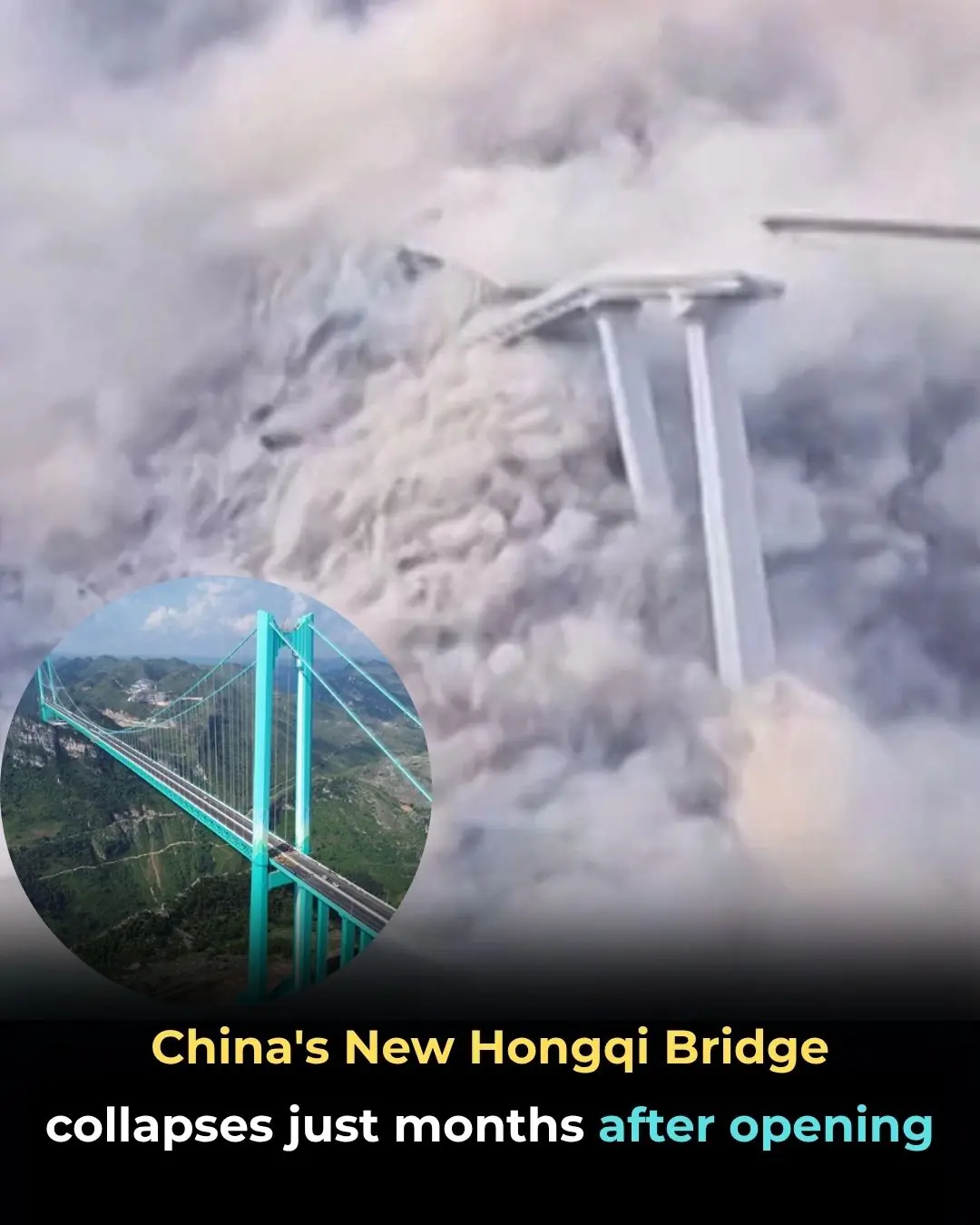
China’s New Hongqi Bridge Collapses Just Months After Opening

A major infrastructure failure in Sichuan Province, China, has drawn international attention after the Hongqi Bridge, a newly constructed 758-meter highway bridge, collapsed only months after opening. The dramatic incident occurred on November 11, 2025, when a massive landslide tore down the mountainside supporting one approach of the bridge, sending part of the structure crashing into the valley below within seconds.
According to early reports from Chinese authorities, the bridge had been closed the day before the collapse. Engineers inspecting the route noticed widening cracks on the roadway and visible deformation on nearby slopes — clear indications of unstable ground movement. Officials halted traffic as a precaution, a decision that likely prevented casualties. No injuries or deaths have been reported.
Video footage captured by local residents shows a huge plume of dust engulfing the canyon as the mountainside collapses, sweeping away a large portion of the bridge deck. The force of the landslide carved through the earth and concrete alike, leaving behind twisted steel and shattered support segments scattered across the ravine.
The Hongqi Bridge was part of China National Highway 317, a strategic route connecting Sichuan to the Tibetan Plateau. This region is famous for its extraordinary natural beauty but is equally known for extreme geological instability, including steep cliffs, loose soil, seismic activity, and frequent landslides. The bridge itself was considered an engineering feat: designed with a 220-meter main span, a rigid-frame structure, and towering piers reaching up to 172 meters. It had officially opened to traffic earlier in 2025, following construction by the Sichuan Road & Bridge Group, one of China’s major state-backed infrastructure companies.
Preliminary investigations indicate that the collapse was triggered primarily by mountainside failure, not a direct structural defect in the bridge. Scientists from the China Earthquake Administration and geotechnical experts cited unusually heavy rainfall, accumulated soil saturation, and deep-seated slope instability as contributing factors. The area sits along a seismically active belt where underground movements can gradually weaken bedrock layers supporting cliffs and highways.
However, the incident has prompted intense scrutiny both inside and outside China. International media outlets such as Reuters, The Washington Post, The Guardian, and CNN International have highlighted growing concerns over the pace and oversight of China’s rapid infrastructure expansion. While China is renowned for building large-scale engineering projects at unparalleled speed, experts worry that accelerated timelines and insufficient long-term geological monitoring may place certain mountain projects at risk.
The collapse has sparked several critical questions among engineers, policymakers, and independent analysts:
1. Rapid Construction Timelines
China often completes massive infrastructure works in record time. While efficient, such speed raises concerns about whether geological surveys and stability assessments receive adequate attention before construction begins. Some specialists argue that mountainous regions require multi-year monitoring, not just pre-build inspections.
2. Safety in High-Risk Mountain Zones
Western Sichuan is one of the world’s most landslide-prone areas. The National Natural Science Foundation of China and the China Academy of Geological Sciences have previously published studies warning that increased rainfall and seismic activity are destabilizing slopes faster than before. The Hongqi Bridge collapse adds to a series of recent landslide incidents across the region.
3. Engineering Oversight in Remote Regions
Remote mountain corridors often make long-term oversight challenging. Experts from the International Association for Engineering Geology note that even well-designed structures can fail if surrounding terrain is unstable or insufficiently reinforced.
4. Monitoring Fast-Tracked Mega Projects
The collapse has renewed debate about whether China's prestige infrastructure projects are monitored rigorously enough after opening. Many engineers insist that large bridges in dynamic geological areas require continuous real-time monitoring, using sensors to detect shifts in soil, rock pressure, and vibration levels.
5. Climate and Environmental Pressures
Studies from the Chinese Academy of Sciences and the United Nations Environment Programme show that climate change is intensifying rainfall patterns in parts of China, increasing the likelihood of catastrophic landslides. As heavy downpours become more frequent, infrastructure built in mountainous regions faces rising long-term risks.
Despite the dramatic imagery and structural damage, officials have emphasized that the prior closure saved lives, and the collapse is currently being treated as an environmental disaster rather than a civil engineering failure. Nevertheless, the government has launched a full investigation, and large-scale slope reinforcement measures are expected.
What was intended to represent progress, connectivity, and engineering achievement has instead become a stark reminder of the profound risks of building in geologically fragile terrain. As China continues expanding transport networks deep into its mountainous interior, the Hongqi Bridge collapse may become a turning point — urging engineers, planners, and policymakers to prioritize long-term geological stability just as much as construction speed.
The event underscores a universal lesson: even the most advanced engineering cannot outrun the forces of nature without constant vigilance.
News in the same category


Jamie Laing admits ‘I’m really scared’ as he shares baby update

Jane Seymour declares ‘70 is the new 50’ after finding love again following four marriages

Tom Cruise, 63, seen laughing with Sydney Sweeney, 28, at Governors Awards after split from Ana de Armas

Cruz Beckham, 20, banned from driving after getting 2 speeding tickets

Ex-Disney star ripped for ‘demonic’ app that lets users talk to AI versions of dead relatives: ‘Literally a ‘Black Mirror’ episode’

Cardi B feels ‘threatened’ after Offset’s paternity comment on singer’s baby with Stefon Diggs: ‘My life is in danger

Denise Richards speaks out after being granted permanent restraining order against ex Aaron Phypers

Fire Beneath the Ice: Antarctica’s Hidden Volcanoes

Rebecca Gayheart reveals living situation as ex Eric Dane battles ALS: ‘Super complicated’

Denise Richards speaks out after being granted permanent restraining order against ex Aaron Phypers

Reason Sara Davies is ‘gutted’ Strictly Come Dancing star Vicky Pattison was voted out of the competition

Emmerdale star Bradley Riches shares lengthy social media message as he celebrates soap achievement

Prince William and Kate Middleton ‘to make Royal Variety performance return’ after two year hiatus

Jamie Laing admits ‘I’m really scared’ as he shares baby update

‘It Was Neglect’: Birmingham Police Haven’t Made an Arrest After Social Worker Left 3-Year-Old Boy In Hot Car to Die Following Shopping Trip; Outraged Family Demands Justice

ITV Emmerdale fans 'work out' villain will violently take down Celia in unexpected twist

‘No First Team Reps UNC?’: Shannon Sharpe Says Kevin Stefanski’s ‘Malpractice’ Is Reason For Shedeur Sanders Rocky Two Quarters Against Desperate Ravens

Alison Hammond reveals 15 year long feud with 'very rude' I'm A Celebrity star
News Post

I’M A CELEB MEDIC SHARES GRIM REASON ALL CONTESTANTS ARE WEARING RED SOCKS

Jamie Laing admits ‘I’m really scared’ as he shares baby update

Jane Seymour declares ‘70 is the new 50’ after finding love again following four marriages

Tom Cruise, 63, seen laughing with Sydney Sweeney, 28, at Governors Awards after split from Ana de Armas

Cruz Beckham, 20, banned from driving after getting 2 speeding tickets

Ex-Disney star ripped for ‘demonic’ app that lets users talk to AI versions of dead relatives: ‘Literally a ‘Black Mirror’ episode’

Cardi B feels ‘threatened’ after Offset’s paternity comment on singer’s baby with Stefon Diggs: ‘My life is in danger

Denise Richards speaks out after being granted permanent restraining order against ex Aaron Phypers

Fire Beneath the Ice: Antarctica’s Hidden Volcanoes

He Drank Sugary Beverages Instead of Water — Doctors Removed Nearly 300 Kidney Stones

Rebecca Gayheart reveals living situation as ex Eric Dane battles ALS: ‘Super complicated’

10 Benefits of Vaseline For Skin, Lips & Hair

Denise Richards speaks out after being granted permanent restraining order against ex Aaron Phypers

Reason Sara Davies is ‘gutted’ Strictly Come Dancing star Vicky Pattison was voted out of the competition

Emmerdale star Bradley Riches shares lengthy social media message as he celebrates soap achievement

Prince William and Kate Middleton ‘to make Royal Variety performance return’ after two year hiatus

Jamie Laing admits ‘I’m really scared’ as he shares baby update

‘It Was Neglect’: Birmingham Police Haven’t Made an Arrest After Social Worker Left 3-Year-Old Boy In Hot Car to Die Following Shopping Trip; Outraged Family Demands Justice
